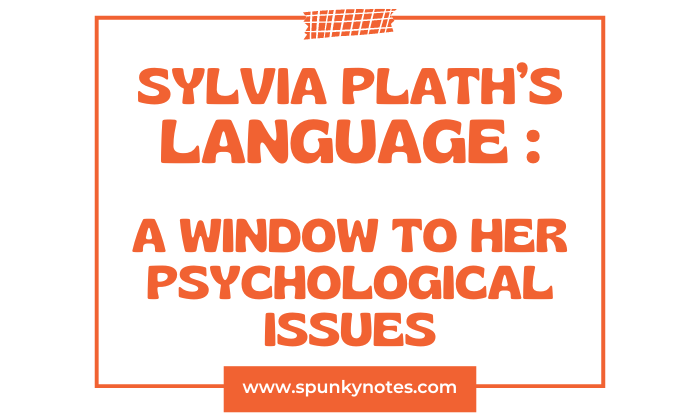

Updated on: December 8, 2023
Estimated Reading Time: 6 min

Estimated Reading Time: 6 min
Q. How does Sylvia Plath’s language and use of imagery convey the complex emotions and psychological issues of her speakers?
Sylvia Plath often employs vivid and powerful images to convey her speakers’ inner emotions and psychological issues. For example, in her poem “Daddy,” Plath uses striking and disturbing imagery to explore the speaker’s conflicted relationship with her father.
Sylvia Plath’s Language and Imagery in Daddy
Language
Plath employs colloquial and formal language in “Daddy” that creates a deeply personal yet universal tone. For instance, she uses informal language, like
Daddy, I have had to kill you, and Daddy, you can lie back now,
This gives the poem a conversational feel. On the other hand, she incorporates more formal language, such as introducing historical and political references.
A man in black with a Meinkampf look and Not God but a swastika
Combining these different language styles allows Plath to convey the speaker’s complex emotions of anger, grief, and confusion.
Imagery
Plath’s imagery in “Daddy” is striking and powerful, often drawing on dark and sinister themes. For instance, she employs Holocaust imagery to convey the speaker’s emotions toward her father:
I began to talk like a Jew.
I think I may well be a Jew” and “I have always been scared of you,
With your Luftwaffe, your gobbledygoo.
And your neat mustache
And your Aryan eye, bright blue.
This imagery evokes the horror and oppression associated with the Holocaust, suggesting the extent of the speaker’s emotional turmoil. Another example of powerful imagery is the vampire motif.
The vampire who said he was you
And drank my blood for a year,
Seven years if you want to know.
This image conveys the idea of a parasitic relationship, reflecting the speaker’s psychological struggle with her father’s influence.
The line “I have always been scared of you, with your Luftwaffe, your gobbledygoo” uses language and imagery that is both unsettling and evocative. It captures the speaker’s fear and anxiety.
Metaphors and similes
Plath’s use of metaphors and similes adds depth to the emotional intensity of “Daddy.” For example, she compares her father to a “black shoe” in which she has lived “like a foot.”
This metaphor illustrates the sense of confinement and suffocation the speaker feels in her relationship with her father. Similarly, she uses the simile “the vampire who said he was you” to suggest her father’s oppressive presence even after his death.
Plath also frequently uses metaphor and symbolism to create layers of meaning within her poetry. In “The Colossus,” she compares the speaker’s father to a giant statue that has fallen and broken into pieces.
This image can be interpreted in several ways, from a metaphor for the speaker’s shattered relationship with her father to a commentary on the decline of traditional patriarchal structures.
In her poem “Mirror,” Plath uses the image of a mirror to explore themes of aging, identity, and self-perception.
I am silver and exact. I have no preconceptions.
Whatever I see I swallow immediately
These lines create a sense of cold detachment and objectivity. It highlights the speaker’s struggle to face her changing appearance and identity.
In “Lady Lazarus,” Sylvia Plath’s language and the use of a circus metaphor explore themes of power, control, and performance.
I do it so it feels like hell. I do it so it feels real,
The line creates a sense of desperation and self-destructiveness in the speaker’s attempts to control her own life and identity.
In “Tulips,” Plath uses the image of a bouquet of tulips to explore themes of vulnerability, mortality, and desire.
I am learning peacefulness, lying by myself quietly
As the light lies on these white walls, this bed, these hands
These lines create a sense of calm. It highlights the speaker’s struggle to come to terms with her mortality and the fragility of human existence. Plath often uses vivid and intense sensory imagery to create a visceral experience for the reader.
In “Morning Song,” she uses the image of a newborn baby to explore themes of birth and motherhood, using sensory details to create a sense of wonder and awe.
the clear vowels rise like balloons
Plath’s use of language is often highly musical and rhythmic. It creates a sense of momentum and movement in her poetry.
In “Ariel,” she uses repetition and alliteration to create a sense of forward motion and energy, with lines like
Stasis in darkness.
Then the substanceless blue
Pour of tor and distances,
creating a sense of motion and momentum.
Plath’s imagery and language often reflect her struggles with mental illness and depression. In “Edge,” for example, she uses the image of a cliff to explore themes of suicide and self-destruction, using the lines to create a sense of finality and despair.
The cliff edge collapses
Its wordlessness
Plath often uses a variety of poetic devices, such as enjambment, alliteration, and assonance, to create a sense of musicality and rhythm in her poetry.
For example, in “Daddy,” she uses repetition and assonance to create a sense of anger and frustration with lines like:
I was ten when they buried you.
At twenty I tried to die
And get back, back, back to you
These lines create a sense of urgency and emotion. Plath often uses natural imagery to convey complex emotions and psychological states.
For example, in “Blackberrying,” she uses the image of blackberries to explore themes of isolation and loneliness, with lines like “The bushes have a purple coloration, a roughness that hints of disobedience,” creating a sense of detachment and melancholy.
Plath’s use of imagery and language is often highly personal and confessional, reflecting her experiences and struggles.
In “Lady Lazarus,” she uses the image of a carnival to explore themes of death and rebirth, using the following lines to create a sense of defiance and strength in the face of adversity.
Out of the ash
I rise with my red hair
And I eat men like air
Sylvia Plath’s vivid imagery creates a sense of intensity and urgency in her poetry. For example, in “A Birthday Present,” she uses the image of a severed head to explore themes of violence and self-destruction, using these lines to create a sense of unease and terror.
The room is completely dark.
A child could play in it,
Alone, without any fear of the dark
In conclusion, Sylvia Plath’s language and imagery define her poetry’s features. She employs vivid and powerful images, metaphors, and symbolism to convey her speakers’ inner emotions and psychological issues, often focusing on identity, mental illness, and the human condition.


